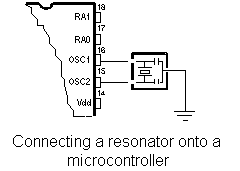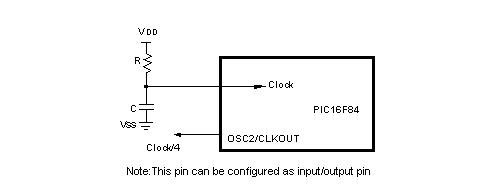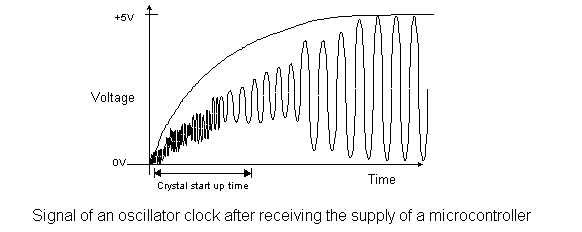Oscillator
Oscillator circuit is used for providing a microcontroller with a clock. Clock is needed so that microcontroller could execute a program or program instructions.
Types of oscillators
PIC16F84 can work with four different configurations of an oscillator. Since configurations with crystal oscillator and resistor-capacitor (RC) are the ones that are used most frequently, these are the only ones we will mention here. Microcontroller type with a crystal oscillator has in its designation XT, and a microcontroller with resistor-capacitor pair has a designation RC. This is important because you need to mention the type of oscillator when buying a microcontroller.
XT Oscillator
Crystal oscillator is kept in metal housing with two pins where you have written down the frequency at which crystal oscillates. One ceramic capacitor of 30pF whose other end is connected to the ground needs to be connected with each pin.
Oscillator and capacitors can be packed in joint case with three pins. Such element is called ceramic resonator and is represented in charts like the one below. Center pins of the element is the ground, while end pins are connected with OSC1 and OSC2 pins on the microcontroller. When designing a device, the rule is to place an oscillator nearer a microcontroller, so as to avoid any interference on lines on which microcontroller is receiving a clock.


RC Oscillator
In applications where great time precision is not necessary, RC oscillator offers additional savings during purchase. Resonant frequency of RC oscillator depends on supply voltage rate, resistance R, capacity C and working temperature. It should be mentioned here that resonant frequency is also influenced by normal variations in process parameters, by tolerance of external R and C components, etc.

Above diagram shows how RC oscillator is connected with PIC16F84. With value of resistor R being below 2.2k, oscillator can become unstable, or it can even stop the oscillation. With very high value of R (ex.1M) oscillator becomes very sensitive to noise and humidity. It is recommended that value of resistor R should be between 3 and 100k. Even though oscillator will work without an external capacitor (C=0pF), capacitor above 20pF should still be used for noise and stability. No matter which oscillator is being used, in order to get a clock that microcontroller works upon, a clock of the oscillator must be divided by 4. Oscillator clock divided by 4 can also be obtained on OSC2/CLKOUT pin, and can be used for testing or synchronizing other logical circuits.

Following a supply, oscillator starts oscillating. Oscillation at first has an unstable period and amplitude, but after some period of time it becomes stabilized.

To prevent such inaccurate clock from influencing microcontroller's performance, we need to keep the microcontroller in reset state during stabilization of oscillator's clock. Diagram above shows a typical shape of a signal which microcontroller gets from the quartz oscillator.
User Comments
Ravikumar
5 years ago
Good explanation.